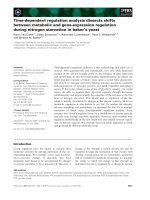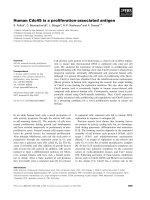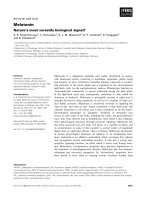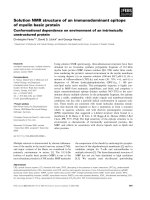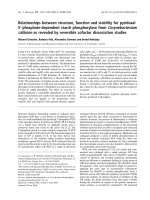Tài liệu Báo cáo khoa học: "Predicate Argument Structure Analysis using Transformation-based Learning" pdf
Bạn đang xem bản rút gọn của tài liệu. Xem và tải ngay bản đầy đủ của tài liệu tại đây (243.78 KB, 6 trang )
Proceedings of the ACL 2010 Conference Short Papers, pages 162–167,
Uppsala, Sweden, 11-16 July 2010.
c
2010 Association for Computational Linguistics
Predicate Argument Structure Analysis using Transformation-based
Learning
Hirotoshi Taira Sanae Fujita Masaaki Nagata
NTT Communication Science Laboratories
2-4, Hikaridai, Seika-cho, Souraku-gun, Kyoto 619-0237, Japan
{taira,sanae}@cslab.kecl.ntt.co.jp
Abstract
Maintaining high annotation consistency
in large corpora is crucial for statistical
learning; however, such work is hard,
especially for tasks containing semantic
elements. This paper describes predi-
cate argument structure analysis using
transformation-based learning. An advan-
tage of transformation-based learning is
the readability of learned rules. A dis-
advantage is that the rule extraction pro-
cedure is time-consuming. We present
incremental-based, transformation-based
learning for semantic processing tasks. As
an example, we deal with Japanese pred-
icate argument analysis and show some
tendencies of annotators for constructing
a corpus with our method.
1 Introduction
Automatic predicate argument structure analysis
(PAS) provides information of “who did what
to whom” and is an important base tool for
such various text processing tasks as machine
translation information extraction (Hirschman et
al., 1999), question answering (Narayanan and
Harabagiu, 2004; Shen and Lapata, 2007), and
summarization (Melli et al., 2005). Most re-
cent approaches to predicate argument structure
analysis are statistical machine learning methods
such as support vector machines (SVMs)(Pradhan
et al., 2004). For predicate argument struc-
ture analysis, we have the following represen-
tative large corpora: FrameNet (Fillmore et al.,
2001), PropBank (Palmer et al., 2005), and Nom-
Bank (Meyers et al., 2004) in English, the Chi-
nese PropBank (Xue, 2008) in Chinese, the
GDA Corpus (Hashida, 2005), Kyoto Text Corpus
Ver.4.0 (Kawahara et al., 2002), and the NAIST
Text Corpus (Iida et al., 2007) in Japanese.
The construction of such large corpora is strenu-
ous and time-consuming. Additionally, maintain-
ing high annotation consistency in such corpora
is crucial for statistical learning; however, such
work is hard, especially for tasks containing se-
mantic elements. For example, in Japanese cor-
pora, distinguishing true dative (or indirect object)
arguments from time-type argument is difficult be-
cause the arguments of both types are often ac-
companied with the ‘ni’ case marker.
A problem with such statistical learners as SVM
is the lack of interpretability; if accuracy is low, we
cannot identify the problems in the annotations.
We are focusing on transformation-based learn-
ing (TBL). An advantage for such learning meth-
ods is that we can easily interpret the learned
model. The tasks in most previous research are
such simple tagging tasks as part-of-speech tag-
ging, insertion and deletion of parentheses in syn-
tactic parsing, and chunking (Brill, 1995; Brill,
1993; Ramshaw and Marcus, 1995). Here we ex-
periment with a complex task: Japanese PASs.
TBL can be slow, so we proposed an incremen-
tal training method to speed up the training. We
experimented with a Japanese PAS corpus with a
graph-based TBL. From the experiments, we in-
terrelated the annotation tendency on the dataset.
The rest of this paper is organized as follows.
Section 2 describes Japanese predicate structure,
our graph expression of it, and our improved
method. The results of experiments using the
NAIST Text Corpus, which is our target corpus,
are reported in Section 3, and our conclusion is
provided in Section 4.
2 Predicate argument structure and
graph transformation learning
First, we illustrate the structure of a Japanese sen-
tence in Fig. 1. In Japanese, we can divide a sen-
tence into bunsetsu phrases (BP). A BP usually
consists of one or more content words and zero,
162
Figure 1: Graph expression for PAS
one, or more than one functional words. Syn-
tactic dependency between bunsetsu phrases can
be defined. Japanese dependency parsers such as
Cabocha (Kudo and Matsumoto, 2002) can extract
BPs and their dependencies with about 90% accu-
racy.
Since predicates and arguments in Japanese are
mainly annotated on the head content word in
each BP, we can deal with BPs as candidates of
predicates or arguments. In our experiments, we
mapped each BP to an argument candidate node
of graphs. We also mapped each predicate to a
predicate node. Each predicate-argument relation
is identified by an edge between a predicate and an
argument, and the argument type is mapped to the
edge label. In our experiments below, we defined
five argument types: nominative (subjective), ac-
cusative (direct objective), dative (indirect objec-
tive), time, and location. We use five transforma-
tion types: a) add or b) delete a predicate node, c)
add or d) delete an edge between an predicate and
an argument node, e) change a label (= an argu-
ment type) to another label (Fig. 2). We explain
the existence of an edge between a predicate and
an argument labeled t candidate node as that the
predicate and the argument have a t type relation-
ship.
Transformation-based learning was proposed
by (Brill, 1995). Below we explain our learn-
ing strategy when we directly adapt the learning
method to our graph expression of PASs. First, un-
structured texts from the training data are inputted.
After pre-processing, each text is mapped to an
initial graph. In our experiments, the initial graph
has argument candidate nodes with corresponding
BPs and no predicate nodes or edges. Next, com-
Figure 2: Transform types
paring the current graphs with the gold standard
graph structure in the training data, we find the dif-
ferent statuses of the nodes and edges among the
graphs. We extract such transformation rule candi-
dates as ‘add node’ and ‘change edge label’ with
constraints, including ‘the corresponding BP in-
cludes a verb’ and ‘the argument candidate and the
predicate node have a syntactic dependency.’ The
extractions are executed based on the rule tem-
plates given in advance. Each extracted rule is
evaluated for the current graphs, and error reduc-
tion is calculated. The best rule for the reduction
is selected as a new rule and inserted at the bottom
of the current rule list. The new rule is applied to
the current graphs, which are transferred to other
graph structures. This procedure is iterated until
the total errors for the gold standard graphs be-
come zero. When the process is completed, the
rule list is the final model. In the test phase, we it-
eratively transform nodes and edges in the graphs
mapped from the test data, based on rules in the
model like decision lists. The last graph after all
rule adaptations is the system output of the PAS.
In this procedure, the calculation of error reduc-
tion is very time-consuming, because we have to
check many constraints from the candidate rules
for all training samples. The calculation order is
O(MN), where M is the number of articles and
N is the number of candidate rules. Additionally,
an edge rule usually has three types of constraints:
‘pred node constraint,’ ‘argument candidate node
constraint,’ and ‘relation constraint.’ The num-
ber of combinations and extracted rules are much
larger than one of the rules for the node rules.
Ramshaw et al. proposed an index-based efficient
reduction method for the calculation of error re-
duction (Ramshaw and Marcus, 1994). However,
in PAS tasks, we need to check the exclusiveness
of the argument types (for example, a predicate ar-
gument structure does not have two nominative ar-
163
guments), and we cannot directly use the method.
Jijkoun et al. only used candidate rules that hap-
pen in the current and gold standard graphs and
used SVM learning for constraint checks (Jijkoun
and de Rijke, 2007). This method is effective
for achieving high accuracy; however, it loses the
readability of the rules. This is contrary to our aim
to extract readable rules.
To reduce the calculations while maintaining
readability, we propose an incremental method
and describe its procedure below. In this proce-
dure, we first have PAS graphs for only one arti-
cle. After the total errors among the current and
gold standard graphs become zero in the article,
we proceed to the next article. For the next article,
we first adapt the rules learned from the previous
article. After that, we extract new rules from the
two articles until the total errors for the articles be-
come zero. We continue these processes until the
last article. Additionally, we count the number of
rule occurrences and only use the rule candidates
that happen more than once, because most such
rules harm the accuracy. We save and use these
rules again if the occurrence increases.
3 Experiments
3.1 Experimental Settings
We used the articles in the NAIST Text Cor-
pus version 1.4β (Iida et al., 2007) based on the
Mainichi Shinbun Corpus (Mainichi, 1995), which
were taken from news articles published in the
Japanese Mainichi Shinbun newspaper. We used
articles published on January 1st for training ex-
amples and on January 3rd for test examples.
Three original argument types are defined in the
NAIST Text Corpus: nominative (or subjective),
accusative (or direct object), and dative (or indi-
rect object). For evaluation of the difficult anno-
tation cases, we also added annotations for ‘time’
and ‘location’ types by ourselves. We show the
dataset distribution in Table 1. We extracted the
BP units and dependencies among these BPs from
the dataset using Cabocha, a Japanese dependency
parser, as pre-processing. After that, we adapted
our incremental learning to the training data. We
used two constraint templates in Tables 2 and 3
for predicate nodes and edges when extracting the
rule candidates.
Table 1: Data distribution
Training Test
# of Articles 95 74
# of Sentences
1,129 687
# of Predicates
3,261 2,038
# of Arguments 3,877 2,468
Nom.
1,717 971
Acc.
1,012 701
Dat.
632 376
Time
371 295
Loc.
145 125
Table 4: Total performances (F1-measure (%))
Type System PRF1
Pred. Baseline 89.4 85.1 87.2
Our system 91.8 85.3 88.4
Arg. Baseline 79.3 59.5 68.0
Our system 81.9 62.4 70.8
3.2 Results
Our incremental method takes an hour. In com-
parison, the original TBL cannot even extract one
rule in a day. The results of predicate and argu-
ment type predictions are shown in Table 4. Here,
‘Baseline’ is the baseline system that predicts the
BSs that contain verbs, adjectives, and da form
nouns (‘to be’ in English) as predicates and pre-
dicts argument types for BSs having syntactical
dependency with a predicted predicate BS, based
on the following rules: 1) BSs containing nomina-
tive (ga) / accusative (wo) / dative (ni) case mark-
ers are predicted to be nominative, accusative, and
dative, respectively. 2) BSs containing a topic case
marker (wa) are predicted to be nominative. 3)
When a word sense category from a Japanese on-
tology of the head word in BS belongs to a ‘time’
or ‘location’ category, the BS is predicted to be a
‘time’ and ‘location’ type argument. In all preci-
sion, recall, and F1-measure, our system outper-
formed the baseline system.
Next, we show our system’s learning curve in
Fig. 3. The number of final rules was 68. This
indicates that the first twenty rules are mainly ef-
fective rules for the performance. The curve also
shows that no overfitting happened. Next, we
show the performance for every argument type in
Table 5. ‘TBL,’ which stands for ‘transformation-
based learning,’ is our system. In this table,
the performance of the dative and time types im-
proved, even though they are difficult to distin-
guish. On the other hand, the performance of the
location type argument in our system is very low.
Our method learns rules as decreasing errors of
164
Table 2: Predicate node constraint templates
Pred. Node Constraint Template Rule Example
Constraint Description Pred. Node Constraint Operation
pos1 noun, verb, adjective, etc. pos1=‘ADJECTIVE’ add pred node
pos2
independent, attached word, etc. pos2=‘DEPENDENT WORD’ del pred node
pos1 & pos2
above two features combination pos1=‘VERB’ & pos2=‘ANCILLARY WORD’ add pred node
‘da’
da form (copula) ‘da form’ add pred node
lemma
word base form lemma=‘%’ add pred node
Table 3: Edge constraint templates
Edge Constraint Template Rule Example
Arg. Cand. Pred. Node Relation
Edge Constraint Operation
Const.
Const. Const.
FW (=func.
word)
∗ dep(arg → pred) FW of Arg. =‘wa(TOP)’ & dep(arg → pred) add NOM edge
∗
FW dep(arg ← pred) FW of Pred. =‘na(ADNOMINAL)’ & dep(arg
← pred)
add NOM edge
SemCat
(=semantic
category)
∗ dep(arg → pred) SemCat of Arg. = ‘TIME’ & dep(arg → pred) add TIME edge
FW
passive form dep(arg → pred) FW of Arg. =‘ga(NOM) & Pred.: passive form chg edge label
NOM → ACC
∗
kform (= type
of inflected
form)
∗ kform of Pred. = continuative ‘ta’ form add NOM edge
SemCat
Pred. SemCat ∗ SemCat of Arg. = ‘HUMAN’ & Pred. SemCat
= ‘PHYSICAL MOVE’
add NOM edge
Figure 3: Learning curves: x-axis = number of
rules; y-axis: F1-measure (%)
all arguments, and the performance of the location
type argument is probably sacrificed for total error
reduction because the number of location type ar-
guments is much smaller than the number of other
argument types (Table 1), and the improvement of
the performance-based learning for location type
arguments is relatively low. To confirm this, we
performed an experiment in which we gave the
rules of the baseline system to our system as initial
rules and subsequently performed our incremen-
tal learning. ‘Base + TBL’ shows the experiment.
The performance for the location type argument
improved drastically. However, the total perfor-
mance of the arguments was below the original
TBL. Moreover, the ‘Base + TBL’ performance
surpassed the baseline system. This indicates that
our system learned a reasonable model.
Finally, we show some interesting extracted
rules in Fig. 4. The first rule stands for an ex-
pression where the sentence ends with the per-
formance of something, which is often seen in
Japanese newspaper articles. The s econd and third
rules represent that annotators of this dataset tend
to annotate time types for which the semantic cate-
gory of the argument is time, even if the argument
looks like the dat. type, and annotators tend to an-
notate dat. type for arguments that have an dat.
165
Figure 4: Examples of extracted rules
Table 5: Results for every arg. type (F-measure
(%))
System Args. Nom. Acc. Dat. Time Loc.
Base 68.0 65.8 79.6 70.5 51.5 38.0
TBL
70.8 64.9 86.4 74.8 59.6 1.7
Base + TBL
69.5 63.9 85.8 67.8 55.8 37.4
type case marker.
4 Conclusion
We performed experiments for Japanese predicate
argument structure analysis using transformation-
based learning and extracted rules that indicate the
tendencies annotators have. We presented an in-
cremental procedure to speed up rule extraction.
The performance of PAS analysis improved, espe-
cially, the dative and time types, which are difficult
to distinguish. Moreover, when time expressions
are attached to the ‘ni’ case, the learned model
showed a tendency to annotate them as dative ar-
guments in the used corpus. Our method has po-
tential for dative predictions and interpreting the
tendencies of annotator inconsistencies.
Acknowledgments
We thank Kevin Duh for his valuable comments.
References
Eric Brill. 1993. Transformation-based error-driven
parsing. In Proc. of the Third International Work-
shop on Parsing Technologies.
Eric Brill. 1995. Transformation-based error-driven
learning and natural language processing: A case
study in part-of-speech tagging. Computational Lin-
guistics, 21(4):543–565.
Charles J. Fillmore, Charles Wooters, and Collin F.
Baker. 2001. Building a large lexical databank
which provides deep semantics. In Proc. of the Pa-
cific Asian Conference on Language, Information
and Computation (PACLING).
Kouichi Hashida. 2005. Global document annotation
(GDA) manual. />Lynette Hirschman, Patricia Robinson, Lisa
Ferro, Nancy Chinchor, Erica Brown,
Ralph Grishman, and Beth Sundheim.
1999. Hub-4 Event’99 general guidelines.
/>projects/muc/.
Ryu Iida, Mamoru Komachi, Kentaro Inui, and Yuji
Matsumoto. 2007. Annotating a Japanese text cor-
pus with predicate-argument and coreference rela-
tions. In Proc. of ACL 2007 Workshop on Linguistic
Annotation, pages 132–139.
Valentin Jijkoun and Maarten de Rijke. 2007. Learn-
ing to transform linguistic graphs. In Proc. of
the Second Workshop on TextGraphs: Graph-
Based Algorithms for Natural Language Processing
(TextGraphs-2), pages 53–60. Association for Com-
putational Linguistics.
166
Daisuke Kawahara, Sadao Kurohashi, and Koichi
Hashida. 2002. Construction of a Japanese
relevance-tagged corpus (in Japanese). Proc. of the
8th Annual Meeting of the Association for Natural
Language Processing, pages 495–498.
Taku Kudo and Yuji Matsumoto. 2002. Japanese
dependency analysis using cascaded chunking. In
Proc. of the 6th Conference on Natural Language
Learning 2002 (CoNLL 2002).
Mainichi. 1995. CD Mainichi Shinbun 94. Nichigai
Associates Co.
Gabor Melli, Yang Wang, Yudong Liu, Mehdi M.
Kashani, Zhongmin Shi, Baohua Gu, Anoop Sarkar,
and Fred Popowich. 2005. Description of
SQUASH, the SFU question answering summary
handler for the DUC-2005 summarization task. In
Proc. of DUC 2005.
Adam Meyers, Ruth Reeves, Catherine Macleod,
Rachel Szekely, Veronika Zielinska, Brian Young,
and Ralph Grishman. 2004. The NomBank project:
An interim report. In Proc. of HLT-NAACL 2004
Workshop on Frontiers in Corpus Annotation.
Srini Narayanan and Sanda Harabagiu. 2004. Ques-
tion answering based on semantic structures. In
Proc. of the 20th International Conference on Com-
putational Linguistics (COLING).
M. Palmer, P. Kingsbury, and D. Gildea. 2005. The
proposition bank: An annotated corpus of semantic
roles. Computational Linguistics, 31(1):71–106.
Sameer Pradhan, Waybe Ward, Kadri Hacioglu, James
Martin, and Dan Jurafsky. 2004. Shallow semantic
parsing using support vector machines. In Proc. of
the Human Language Technology Conference/North
American Chapter of the Association of Computa-
tional Linguistics HLT/NAACL 2004.
Lance Ramshaw and Mitchell Marcus. 1994. Explor-
ing the statistical derivation of transformational rule
sequences for part-of-speech tagging. In The Bal-
ancing Act: Proc. of the ACL Workshop on Com-
bining Symbolic and Statistical Approaches to Lan-
guage.
Lance Ramshaw and Mitchell Marcus. 1995. Text
chunking using transformation-based learning. In
Proc. of the third workshop on very large corpora,
pages 82–94.
Dan Shen and Mirella Lapata. 2007. Using se-
mantic roles to improve question answering. In
Proc. of the 2007 Joint Conference on Empir-
ical Methods in Natural Language Processing
and Computational Natural Language Learning
(EMNLP/CoNLL), pages 12–21.
Nianwen Xue. 2008. Labeling Chinese predicates
with semantic roles. Computational Linguistics,
34(2):224–255.
167

